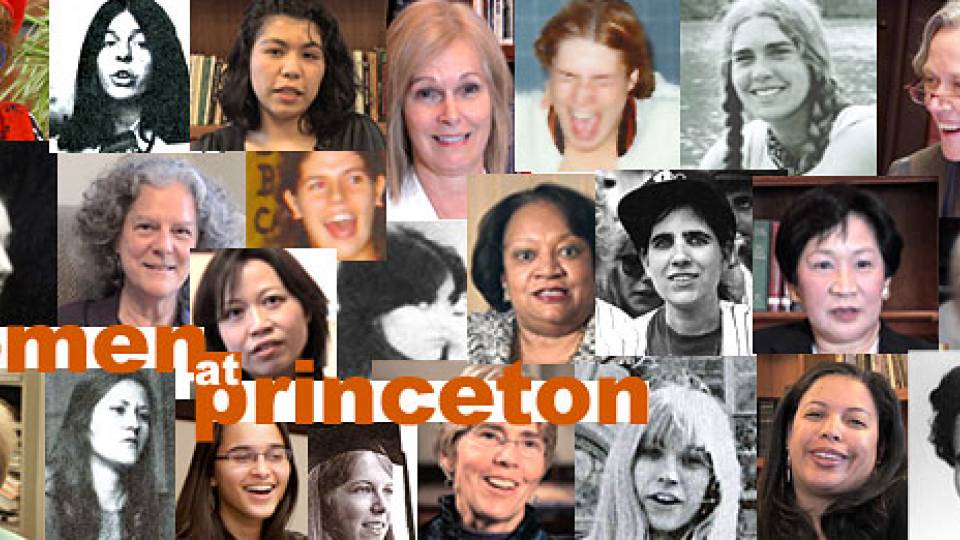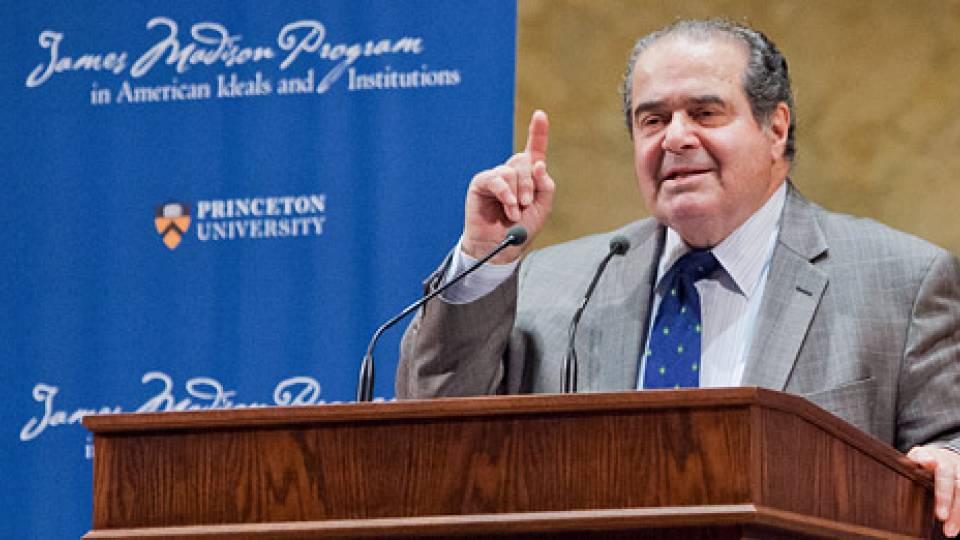In a conversation with Princeton President Shirley M. Tilghman Friday, April 29, U.S. Supreme Court Justice Sonia Sotomayor talked about forces that have shaped her life's journey and approach to the law, from her role models and mentors to institutions such as Princeton, her alma mater.
"Because I needed to learn so much when I was here and the small personal environment at University, I was able to find professors that helped me grow," said Sotomayor, a 1976 Princeton alumna and trustee. "And that was what catapulted me into the rest of my life. It turned out ultimately to become a home that was so foundational for my growth and development."
The event, held in Princeton's Jadwin Gymnasium, was part of the four-day conference organized by the Alumni Association titled "She Roars: Celebrating Women at Princeton," which brought more than 1,200 alumnae and guests to the University. The gathering marked the University's progress since Princeton admitted its first female graduate degree candidate in 1961 and the beginning of undergraduate coeducation in 1969. The conversation between Sotomayor and Tilghman also was open to Princeton students, faculty and staff.
The event was introduced by Stephen Oxman, chair of the executive committee of the Princeton University Board of Trustees, who said it was the "capstone of a tremendously memorable day."

Sotomayor (left) relayed personal anecdotes in her conversation with Princeton President Shirley M. Tilghman about her decision to attend Princeton and some of the highs and lows of legal practice, going through the confirmation process and sitting on the bench.
In her introduction of Sotomayor, Tilghman said she is "an alumna who personifies the great strides women have made since coeducation," whose story is not only "inspiring, but has become the stuff of legend."
As a student at Princeton, Sotomayor earned an A.B. with highest honors in history and was a recipient of the University's highest undergraduate honor, the Pyne Prize, which is awarded to the senior who has most clearly manifested excellent scholarship, strength of character and effective leadership.
Sotomayor was appointed a U.S. District Court judge for the Southern District of New York in 1992, was confirmed to the U.S. Court of Appeals for the 2nd Circuit in 1998 and was appointed to the U.S. Supreme Court in 2009.
In their hourlong conversation presented in an interview format, Sotomayor and Tilghman discussed the justice's road to Princeton, her interest in the law, her experience as a woman in the field, her judicial philosophy and process, and her recent experiences being nominated to and joining the Supreme Court.
Sotomayor said her self-confidence came from her mother, who moved to the United States from Puerto Rico, mastered English, went to college for nursing and raised two children.
As Sotomayor's career developed as a prosecutor and a judge, she said she faced subtly dismissive treatment from male peers. "Those things, they don't realize, can have an effect on you. They can be demoralizing at times. I don't think to the young women in the room that I can make a promise that you won't experience it; the likelihood is that you will," she said. "Your challenge will be, as it was for me and as it was for every accomplished woman in the room, to understand that it should not undermine your confidence in yourself. You have to recognize it, accept it for what it is and push past it."
As for her judicial philosophy, Sotomayor said it evolved as she worked her way up through the system and observed the different approaches of her colleagues.
"I am and have always been a rule follower, and so I am very precedent bound and practical, fact bound. That's in my nature," she said. "But there's something about judging that required a certain type of vision, not seeing beyond the case or policy, but to see the entire relationship of those cases to the law. That's basically what you do on the Supreme Court, but you're not deciding that individual case in the abstract. You're deciding what the statement of law you will make or establish in that case, the interpretation of what the law is, with a very real recognition that you're going to affect what comes next because you've set that boundary."
On the question of whether she looks at the Constitution for original intent or as a living document, Sotomayor said the answer can be quite nuanced.
"The reality is that the judicial process is often dealing with situations [where the] original meaning is very difficult to discern," she said. "If you are thinking about original intent, you have to think about what the principles were that were guiding the Founding Fathers and the structure of the society that they were in that led them to those principles. If you're a justice in today's society, you have to extrapolate those principles. … The Constitution in many of its provisions is worded very, very broadly. The founders' intent was that it could be applied through the ages. We've been doing a pretty darn good job of doing that."

Sotomayor captivated the audience -- made up of Princeton students, faculty and staff and attendees of the conference -- with her discussion of the judicial system and finding her role within it.
Sotomayor described her nomination to the Supreme Court as a "whirlwind" experience; one that brought her to tears upon learning of her appointment. She said she has found the court to be a very collegial place, despite the strong disagreements that arise over cases, crediting the respect the justices have for each other's intellect and good faith. Former justice John Paul Stevens was her closest confidante her first year, offering guidance about the law and judicial process as well as giving her confidence. She said she has also found the experience of losing her privacy and anonymity painful, even as she is grateful for the opportunity to serve.
After the event, 2010 graduate Elizabeth Rosen said she found the presentation a "wonderful, rare, precious opportunity to hear a Supreme Court justice and alumna speak in an honest, forthcoming, brilliant way about her path and background." Rosen, a Princeton Project 55 fellow based in Washington, D.C., plans to attend Harvard Law School in the fall and said she gained valuable insights from Sotomayor's comments.
"As a future lawyer, it was great to hear her talk about the meaning of justice and about the judicial process … what she said will inform my approach," Rosen said. "I couldn't have predicted what a wonderful storyteller she was."
Kelli Garcia, a member of the class of 1996 who is an attorney in Washington, D.C., said she was "thrilled" to see Sotomayor, who was the main reason for her attending the conference. "It's important to have women in these roles," she said.

Watch Princeton women -- alumnae, students, and faculty and staff -- talk about the history of women at Princeton in this video.
The "She Roars" conference, which concludes Sunday, May 1, celebrates the history of women at Princeton, notes their accomplishments in society and looks forward to challenges that remain. A video documenting the history of women at Princeton was screened at the conference.
The conference's first session on Friday morning featured Tilghman in another conversation with participants. She discussed various efforts at the University that are important to better supporting female -- and male -- students, including the four-year residential college system launched in 2007, the arts initiative begun in 2006, the athletics program and its winning teams (such as this year's men's and women's basketball squads), and the "Princeton in the World" international initiative started in 2007.

Chair of the executive committee of Princeton's Board of Trustees and 1967 alumnus Stephen Oxman (left) presents Sotomayor (middle) with a "She Roars" scarf as Tilghman looks on.
Several alumnae expressed thanks to Tilghman and to the Alumni Association for organizing the conference.
"The unspoken boundary of gender bias was one people didn't talk about until Shirley Tilghman came on board," said 1977 graduate Eve Kornfeld. "[Previously] we faced the challenges and carried that experience into the world, using the power to challenge all that seemed unchangeable."
The conference's lectures and discussions focus on issues facing women on campus and in professional and personal realms, and the events feature Princeton students, faculty, administrators and other prominent alumnae, such as U.S. Environmental Protection Agency Administrator Lisa Jackson, a 1986 graduate alumna; chair and CEO of Avon Products, Inc., Andrea Jung, a 1979 alumna; CEO and founder of Teach for America Wendy Kopp, a 1989 graduate; and novelist Jodi Picoult, a 1987 alumna.
View the full She Roars schedule (.pdf) at the conference website.

More than 1,200 alumnae (in orange lanyards) are attending the four-day conference that notes their accomplishments in society and looks forward to challenges that remain.



